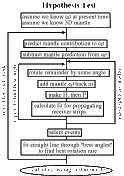

Differential rotation of the inner core has been inferred by
several body-wave studies with most agreeing that
a superrotation may exist with a rate between 0.2 and 3 degress per year.
The wide range of inferred rotation
rates is caused by the sensitivity of such studies to local
complexities in structure which have been
demonstrated to exist.
Free-oscillation "splitting functions" are insensitive to local structure and
are therefore better candidates for estimating differential inner core rotation.
The exact cause for the signal in our splitting functions (3D heterogeneity or
anisotropy) is irrelevant in our study. All we are interested in is whether the
patters change with time.

| Spectra from vertical recordings of of individual stations show anomalously split inner-core sensitive modes (here 13S2). Due to 3D structure of the Earth, the ''spectral peak'' exhibits fine-scale splitting, within a band defined as the splitting width (grey area). Some spectra even exhibit clearly split peaks (ANMO, CCM). Rotation and hydrostatic ellipticity of the Earth cause a splitting of only 6.7mHz (black bar). The smaller peaks at 4.87 mHz are the faster decaying mode 9S7. For each of the 45 earthquakes in our database (spread over 24 years), we collapse the typically 100 spectra into receiver strips, without loss of information. See background information for details. Even though the Bonin Islands earthquake was 20 times smaller than the Bolivia event, it excited the mode well enough to produce high signal-to-noise strips. On the other hand, the greater Indian Ocean event on June 19, 2000 did not excite this particular mode sufficiently well to be considered in this analysis. |

|
A selection of high signal-to-noise receiver strips
is then used to determine the splitting matrix, and
ultimately the splitting function.
The receiver strips are
autoregressive. We use this property
to formulate a linear inverse problem for the propagator
matrix P(t)= exp[i(H+Iw)t], solve for the splitting
matrix, H, and ultimately determine the elastic splitting
function f(q,f). An advantage of the autoregressive technique over other techniques is that it does not use any earthquake-related terms (the a(0) cancel out). By using events from different time periods (e.g. 1977-1985 vs. 1994-2001) we can, in principle, investigate the time-dependence of the splitting function. We show a comparison of splitting functions for mode 13S2, corrected for crust and mantle structure. The correlation plot shows the correlation at degrees 2 and 4 (and their sum) of the non-zonal patterns as a function of rotation angle about the rotation axis (relative longitude). harmonic degrees 2 and 4 require different angles for the highest correlation which is inconsistent with the inner core rotating as a ridig body. We suspect that this inconsistency originates from errors in the poorly determined old splitting functions that lack recordings of suitable earthquakes. We therefore abandon this type of comparison and adopt a forward approach which is described in the next section. |

|
In a forward modelling approach we test the hypothesis
that the inner core is rotating at a certain rate. We
then test whether the receiver strips over time are consistent with this rate.
Using only modern data we determine the current
splitting function of a mode.
We subtract the
mantle
signal from this splitting function
(
corrected splitting function ).
For a given earthquake, we rotate the remaining "core-splitting function" using an assumed rotation rate. The mantle signal is then added back to the splitting function and the propagator matrix, P, is reconstructed. We then determine how well P maps a receiver strip bn into a lagged one, bn+1. By iterating this procedure we find the best rotation rate for each earthquake and a best fitting rate is determined assuming that the rotation rate does not change over time. This is repeated for each mode, and the average over all modes gives our final inner core rotation rate. |
Our initial results on inner core rotation:
Laske, G. and G. Masters, Limits on differential rotation of the
inner core from an analysis of the Earth's free oscillations.
Nature, 402, 66-68, 1999.
pdf